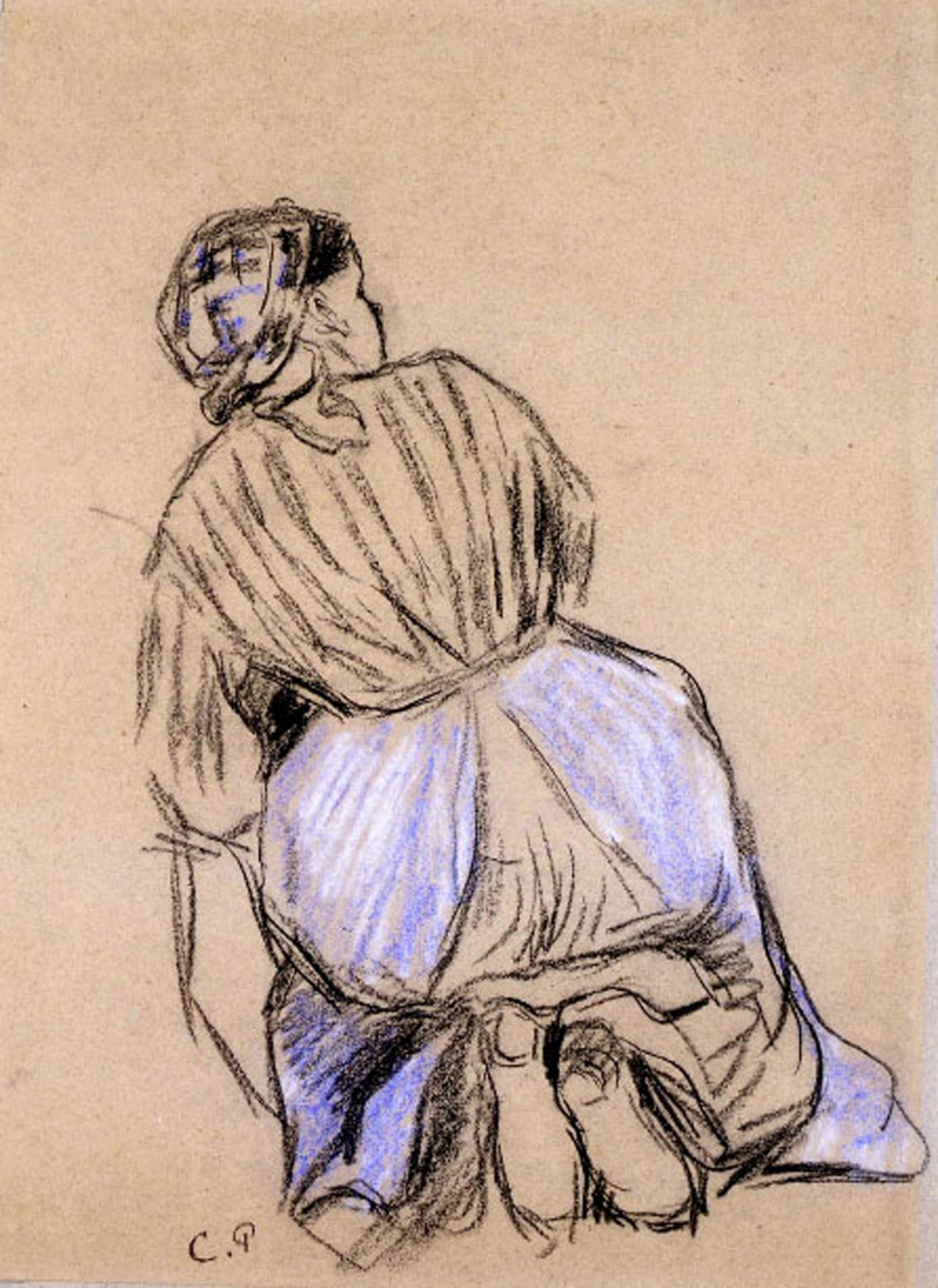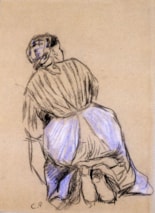Camille PISSARRO
(Saint-Thomas 1830 - Paris 1903)
Study of a Kneeling Washerwoman, Seen from Behind
Sold
Charcoal with white and blue chalk on blue-gray paper.
Signed with initials C.P at the lower left.
433 x 309 mm. (17 1/8 x 12 1/8 in.) [image]
458 x 345 mm. (18 x 13 5/8 in.) [sheet]
Signed with initials C.P at the lower left.
433 x 309 mm. (17 1/8 x 12 1/8 in.) [image]
458 x 345 mm. (18 x 13 5/8 in.) [sheet]
This drawing is a preparatory study for one of the kneeling washerwomen in Pissarro’s painting Shepherd and Washerwomen at Montfoucault, signed and dated 1881, in the Mohamed Mahmoud Khalil Museum in Giza, Egypt. The painting was exhibited, as Le berger et les laveuses, at the seventh Impressionist exhibition in 1882, where it was one of several canvases by the artist in which peasant women were particularly prominent. As one critic noted of the painting in a review of the exhibition, ‘Pissarro places his peasant women in front of the actual work they are doing: here they are washing on the banks of a watercourse, their sleeves rolled up, the small of their back straining, their hands red, they are caught working and are gloriously real.’ In another review of the ‘7me Exposition des Artistes Indépendants’, the critic Ernest Chesneau wrote of Pissarro’s exhibited paintings, which included the Khalil picture, that ‘Since Millet, no one has observed and depicted the peasant with such powerful vigor and with this accurate and personal vision’, while J.-K. Huysmans added that ‘Pissarro exhibits an entire series of peasant men and women, and once again this painter shows himself to us in a new light...He paints his country people without false grandeur, simply as he sees them. His delicious little girls in their red stockings, his old woman wearing a kerchief, his shepherdesses and laundresses, his peasant girls cutting hay or eating, all are true small masterpieces.’ Similar sentiments have been expressed by more recent scholars when discussing the Khalil painting in particular; ‘Two peasant women kneeling beside a stream have turned stiffly in unison to look up at the calm, imposing figure of a shepherd. Caught in the low rays of the setting sun, the figures seem frozen in a timeless tableau, suggestive of the dignity of their traditional tasks. It was doubtless this quality that led the critic Chesneau to compare Pissarro to Millet, a comparison that Pissarro rejected with heat and humor.’ The scene depicted in the painting takes place at the edge of the pond near the farm of Montfoucault, near Mayenne in eastern Brittany, owned by Pissarro’s close friend Ludovic Piette. The artist and his family made a number of visits to Montfoucault between 1864 and 1876. It should be noted, however, that the Khalil Shepherd and Washerwomen at Montfoucault must have been painted in the Pissarro’s studio at Pontoise, since in 1881 he had not been to Montfoucault for several years. The composition of the painting is in fact derived from a canvas painted at Montfoucault five years earlier, in 1876, in which, however, only one washerwoman is shown. While the pose of the woman in the present sheet is superficially similar to that in the 1876 painting, it is closer to the figure in the later work.
Born on the island of St. Thomas in the Danish West Indies and raised in Paris, Camille Pissarro was essentially self-taught as an artist, with little formal training. In 1859 he enrolled at the Académie Suisse, where he met Paul Cézanne, Armand Guillaumin and Claude Monet. He exhibited at the Paris Salons throughout the 1860’s, although his paintings received little critical or public attention and he sold very few. By 1866 he had settled in the town of Pontoise, where he was to work - apart from a brief stay in London during the Franco-Prussian war - until 1884, when he moved to Éragny-sur-Epte. The only artist to participate in all eight Impressionist exhibitions, Pissarro nevertheless remained somewhat less well known than many of his fellow painters. Indeed, as he wrote in a letter of 1895, ‘Like Sisley, I remain in the rear of Impressionism’.
Along with Edgar Degas, Camille Pissarro was the most prolific draughtsman among the Impressionists, with a surviving corpus of drawings far greater than those of Edouard Manet, Auguste Renoir, Claude Monet or Paul Cézanne. He drew in pencil, charcoal, watercolour, pastel and gouache, as well working with various forms of printmaking. As has been noted by John Rewald, ‘with real passion he explored the many possibilities of these methods, achieving in each an uncontested mastery, not so much because of technical proficiency as because he knew how to use each medium for the purpose of expressing what he wished to say.’
Pissarro once wrote to his son that ‘It is only by drawing often, drawing everything, drawing incessantly, that one fine day you discover to your surprise that you have rendered something of its true character.’ Indeed, as Christopher Lloyd has noted, ‘A close study of Pissarro’s drawings shows that, like Degas, he prepared his compositions with the utmost precision and care before beginning work on the canvas. The method of preparation was not always a question of plotting the design ready for transference on to the canvas itself, but of building up an impressive range of visual information that could be introduced or omitted as the painter refined his thoughts about a particular composition...What emerges from all this is that Pissarro is an impressionist painter who uses drawings in a strictly traditional manner, but, as in his paintings, what makes this connection particularly interesting is the contrast between the orthodoxy of his approach and the radicalism of the results.’ Pissarro seems to have drawn much more in the last two decades of his career than he had before; indeed almost three–quarters of the artist’s extant drawings may be dated to the 1880s and 1890s. Also particularly noticeable in his drawings at the end of the 1870s and the early 1880s is an increased interest in studies of the human figure.
Provenance
Anonymous sale, London, Sotheby’s, 22 April 1971, lot 21 (bt. M. de Botton for £2,600).





